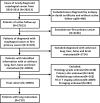Lung Metastases in Newly Diagnosed Esophageal Cancer: A Population-Based Study
- PMID: 33718154
- PMCID: PMC7947855
- DOI: 10.3389/fonc.2021.603953
Lung Metastases in Newly Diagnosed Esophageal Cancer: A Population-Based Study
Abstract
Background: Esophageal cancer is one of the most common cancer types, with its most common distant metastatic site being the lung. Currently, population-based data regarding the proportion and prognosis of patients with esophageal cancer with lung metastases (ECLM) at the time of diagnosis is insufficient. Therefore, we aimed to determine the proportion of patients with ECLM at diagnosis, as well as to investigate the prognostic parameters of ECLM.
Methods: This population-based observational study obtained data from the Surveillance, Epidemiology, and End Results (SEER) database registered between 2010 and 2016. Multivariable logistic regression was performed to identify predictors of the presence of ECLM at diagnosis. Multivariable Cox regression and competing risk analysis were used to assess prognostic factors in patients with ECLM. Median survival was estimated using Kaplan-Meier curves.
Results: Of 10,965 patients diagnosed with esophageal cancer between 2010 and 2016, 713 (6.50%) presented with initial lung metastasis at diagnosis. Lung metastasis represented 27.15% of all cases with metastatic disease to any distant site. Considering all patients with esophageal cancer, multivariable logistic regression indicated that pathology grade, pathology type, T staging, N staging, race, and number of extrapulmonary metastatic sites were predictive factors for the occurrence of lung metastases at diagnosis. The median survival time of patients with ECLM was 4.0 months. Patients receiving chemotherapy or chemoradiotherapy had the longest median overall survival, 7.0 months. Multivariable Cox regression indicated that age, histology type, T2 staging, number of extrapulmonary metastatic sites, and treatment (chemotherapy, radiotherapy, or chemoradiotherapy) were independent predictors for overall survival (OS). Multivariable competing risk analysis determined that age, number of extrapulmonary metastatic sites, and treatment were independent predictors for esophageal cancer-specific survival (CSS).
Conclusion: The findings of this study may provide important information for the early diagnosis of ECLM, as well as aid physicians in choosing appropriate treatment regimens for these patients.
Keywords: SEER program; esophageal cancer; lung metastases; survival; treatment.
Copyright © 2021 Guo, Zhang, Li, Hassan, Lu, Zhao and Zhang.
Conflict of interest statement
The authors declare that the research was conducted in the absence of any commercial or financial relationships that could be construed as a potential conflict of interest.
Figures



Similar articles
-
Frequency and Prognosis of Pulmonary Metastases in Newly Diagnosed Gastric Cancer.Front Oncol. 2019 Jul 30;9:671. doi: 10.3389/fonc.2019.00671. eCollection 2019. Front Oncol. 2019. PMID: 31417862 Free PMC article.
-
Liver Metastases in Newly Diagnosed Gastric Cancer: A Population-Based Study from SEER.J Cancer. 2019 Jun 2;10(13):2991-3005. doi: 10.7150/jca.30821. eCollection 2019. J Cancer. 2019. PMID: 31281476 Free PMC article.
-
A Population-Based Study on Liver Metastases in Women With Newly Diagnosed Ovarian Cancer.Front Oncol. 2020 Sep 25;10:571671. doi: 10.3389/fonc.2020.571671. eCollection 2020. Front Oncol. 2020. PMID: 33102229 Free PMC article.
-
The risk and prognostic factors for brain metastases in esophageal cancer patients: an analysis of the SEER database.BMC Cancer. 2021 Sep 26;21(1):1057. doi: 10.1186/s12885-021-08802-8. BMC Cancer. 2021. PMID: 34563149 Free PMC article.
-
The prognostic effect of metastasis patterns on overall survival in patients with distant metastatic bladder cancer: a SEER population-based analysis.World J Urol. 2021 Nov;39(11):4151-4158. doi: 10.1007/s00345-021-03721-6. Epub 2021 May 24. World J Urol. 2021. PMID: 34028594
Cited by
-
Comparing the prognosis of esophageal adenocarcinoma with bone and liver metastases: A competing risk analysis.PLoS One. 2024 Sep 25;19(9):e0303842. doi: 10.1371/journal.pone.0303842. eCollection 2024. PLoS One. 2024. PMID: 39321194 Free PMC article.
-
A population-based investigation: How to identify high-risk T1-2N0 esophageal cancer patients?Front Surg. 2023 Jan 17;9:1003487. doi: 10.3389/fsurg.2022.1003487. eCollection 2022. Front Surg. 2023. PMID: 36733675 Free PMC article.
-
Models for Predicting Early Death in Patients With Stage IV Esophageal Cancer: A Surveillance, Epidemiology, and End Results-Based Cohort Study.Cancer Control. 2022 Jan-Dec;29:10732748211072976. doi: 10.1177/10732748211072976. Cancer Control. 2022. PMID: 35037487 Free PMC article.
-
Editorial: Chemo-Radiation-Resistance in Cancer Therapy.Front Pharmacol. 2022 May 18;13:904063. doi: 10.3389/fphar.2022.904063. eCollection 2022. Front Pharmacol. 2022. PMID: 35662703 Free PMC article. No abstract available.
-
A nomogram model to individually predict prognosis for esophageal cancer with synchronous pulmonary metastasis.Front Oncol. 2023 Jan 4;12:956738. doi: 10.3389/fonc.2022.956738. eCollection 2022. Front Oncol. 2023. PMID: 36686804 Free PMC article.
References
LinkOut - more resources
Full Text Sources
Other Literature Sources

